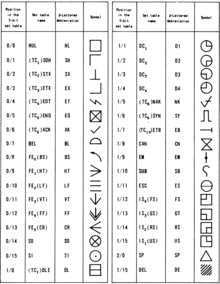
ISO 2047 (Information processing – Graphical representations for the control characters of the 7-bit coded character set) is a standard for graphical representation of the control characters for debugging purposes, such as may be found in the character generator of a computer terminal; it also establishes a two-letter abbreviation of each control character.[1] The graphics and two-letter codes are essentially unchanged from the 1968 European standard ECMA-17[2] and the 1973 American standard ANSI X3.32-1973.[3] It became an ISO standard in 1975.[1] It is also standardized as GB/T 3911-1983 in China, as KS X 1010[4] in Korea (formerly KS C 5713), and was enacted in Japan as "graphical representation of information exchange capabilities for character" JIS X 0209:1976 (former JIS C 6227) (abolished January 20, 2010).
While the ISO/IEC 646 three-letter abbreviations (such as "ESC"), or caret notation (such as "^[") are still in use, the graphical symbols of ISO 2047 are considered outdated and rare.[5]
- ^ a b "ISO 2047:1975 Information processing – Graphical representations for the control characters of the 7-bit coded character set". ISO. Archived from the original on 2 August 2020. Retrieved 13 April 2020.
- ^ "ECMA-17, Graphic Representation of the Control Characters of the ECMA 7-Bit Coded Character Set for Information Interchange". Archived from the original on 2023-12-02. Retrieved 2024-05-08. (withdrawn)
- ^ "American National Standard – Graphic Representation of the Control Characters of American National Standard Code for Information Interchange". American National Standards Institute. 3 July 1973.
- ^ "KS X 1010-2007 Graphical representations control characters for Information interchange".[permanent dead link]
- ^ Agim Çami, "Control characters in ASCII and Unicode" (PDF). Agim Çami – Computer Architecture web site. 1 July 2019. Archived (PDF) from the original on 6 October 2021. Retrieved 5 August 2020.